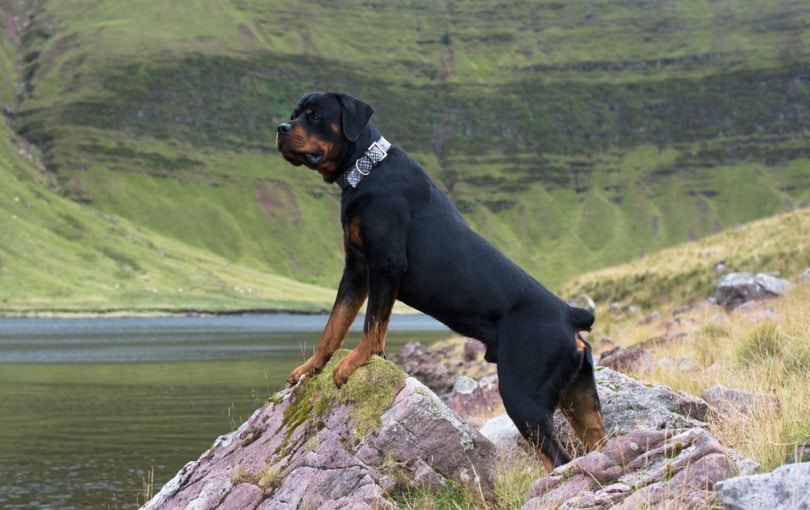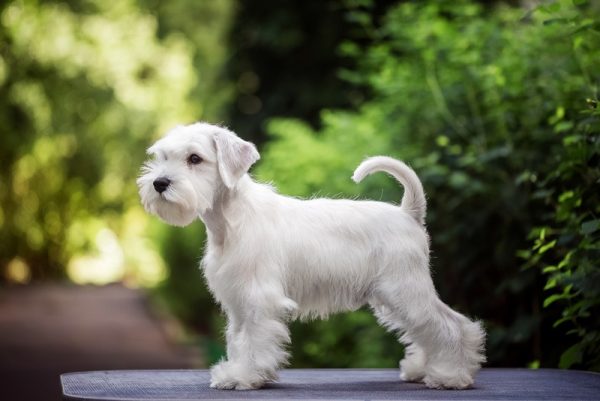Despite having an unfair reputation as fierce junkyard guard dogs, Rottweilers were bred as multi-faceted herding and farm dogs. In ancient times, they were used to herd livestock and guard farms. In some cases, they were used to pull small carts.
While they’ve done various canine jobs over the years, these days, Rottweilers are mostly regarded as big softies that enjoy lounging around with their owners. So, are Rottweilers good herding and farm dogs? Absolutely!

What Is a Farm Dog?
Farm dogs are usually used for herding, but they may also be expected to have droving, guarding, and pest-control duties. In this respect, Rottweilers make excellent farm dogs.

History of the Rottweiler as a Herding and Farm Dog
While they are primarily pets now, nearly all breeds were created for a specific purpose. Dating back to Ancient Rome, the Rottweiler was a herding and driving dog that could handle livestock and protect them from predators.1
Modern Rottweilers differ from their ancestors significantly, however. When ancient Rottweilers were brought across the Alps, they were bred with native dogs in Germany to create what we know as Rottweilers today.
In Germany, this breed was used by butchers to pull meat carts to market and protect them. So, throughout their history, the Rottweiler has been used for herding cattle, protecting people and livestock, and pulling carts.

What Farm Tasks Can Rottweilers Perform?
Rottweilers can excel at many farm tasks, including the following.
Herding
While we may think of heelers, sheepdogs, Collies, and Corgis as herding dogs, the Rottweiler also has a long and exceptional herding history. They will naturally herd cattle, sheep, goats, and other types of livestock, often without any training.
Droving
Droving is the practice of moving livestock across a long distance. Rottweilers have had this ability since their time in Ancient Rome, when cattle and other animals were driven along with the army. While most people don’t do droving anymore, since we have more efficient ways of moving livestock over distances, it can still be helpful for large farms and ranches that need to move livestock a few miles.

Pest Removal
Farms are susceptible to pests, such as rats, mice, groundhogs, and other vermin. Dogs are quite helpful with pest control (sometimes more than cats!). Small breeds, such as Dachshunds and Jack Russell Terriers, are bred specifically to hunt small game, but the Rottweiler is also an effective hunter with a high prey drive.
That said, they may not be the best choice for a farm that has small animals that you want to keep, such as chickens and other birds, cats, and small dogs. If you expect that this will be an issue, you can train and socialize your Rottweiler to live in harmony with small animals.
Protection
Staying true to the pop culture depiction, Rottweilers are excellent guard dogs. The protective instinct has been bred into them for thousands of years, so they’re hard-wired to protect homes, properties, owners, and livestock.
The downside is that this ingrained guard dog instinct can lead to an aggressive or suspicious canine. You won’t need to train a Rottweiler to protect you, but you may need to train them to manage their protective instinct appropriately.
Another consideration is for livestock guardians. There’s a difference between a guard dog that protects livestock from the outside, as Rottweilers have done, and a livestock guardian dog that lives with and protects the animals. These types of guardian dogs learn to live in harmony with goats, sheep, and other livestock and tend to be gentle and accommodating. Rottweilers may be too large and rough to live and sleep with some livestock, and they may get carried away with the instinct to chase and hunt.

Conclusion
Rottweilers have excelled at numerous farm and herding duties over millennia. While modern Rottweilers may not be suitable for every farm or task, they’re still capable of being herding and guard dogs in the right circumstances. The best way to set up your Rottweiler for a happy and healthy life on a farm is with a solid training foundation and appropriate manners around livestock and small animals.
Featured Image Credit: PhotoDOGraphy, Shutterstock



















